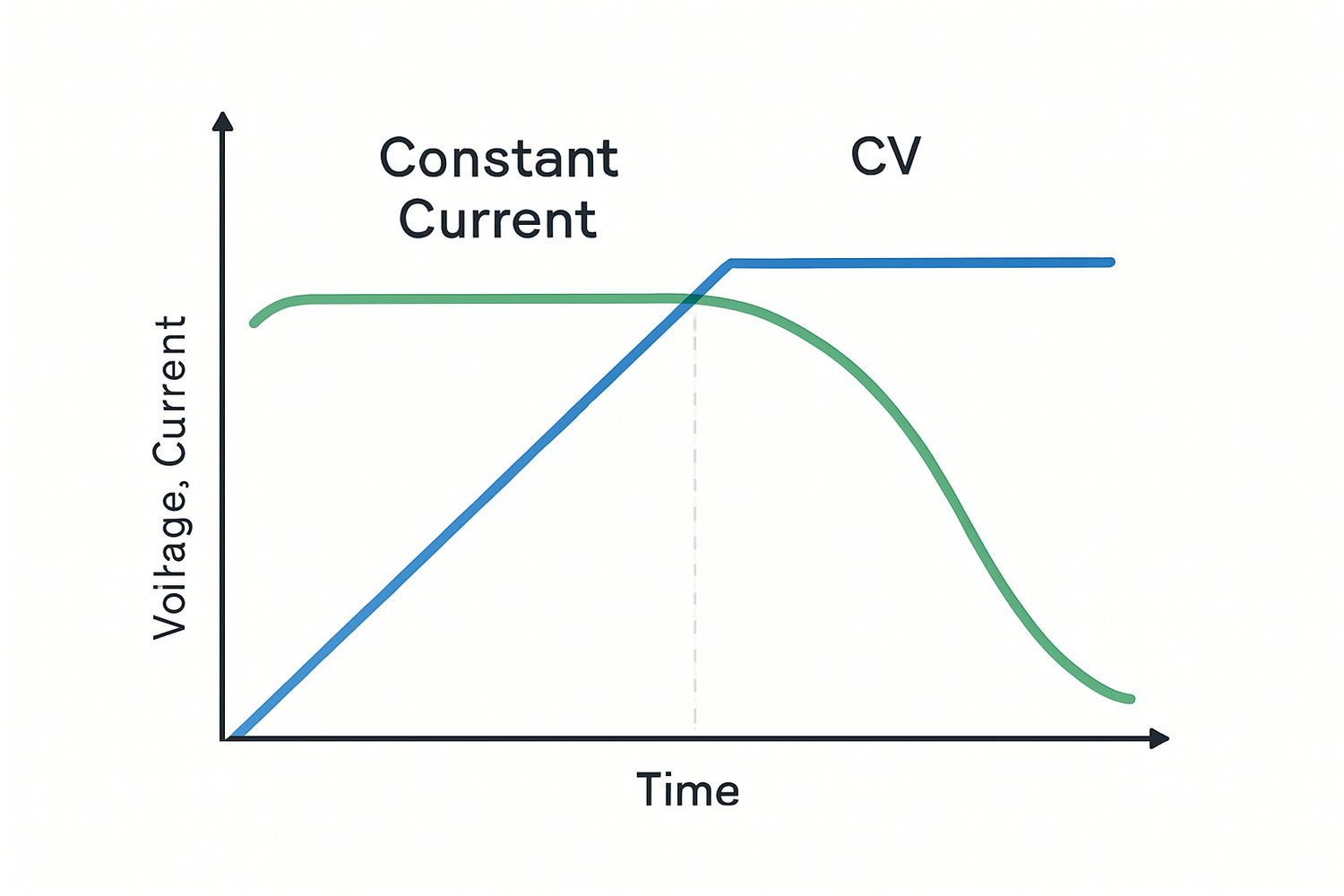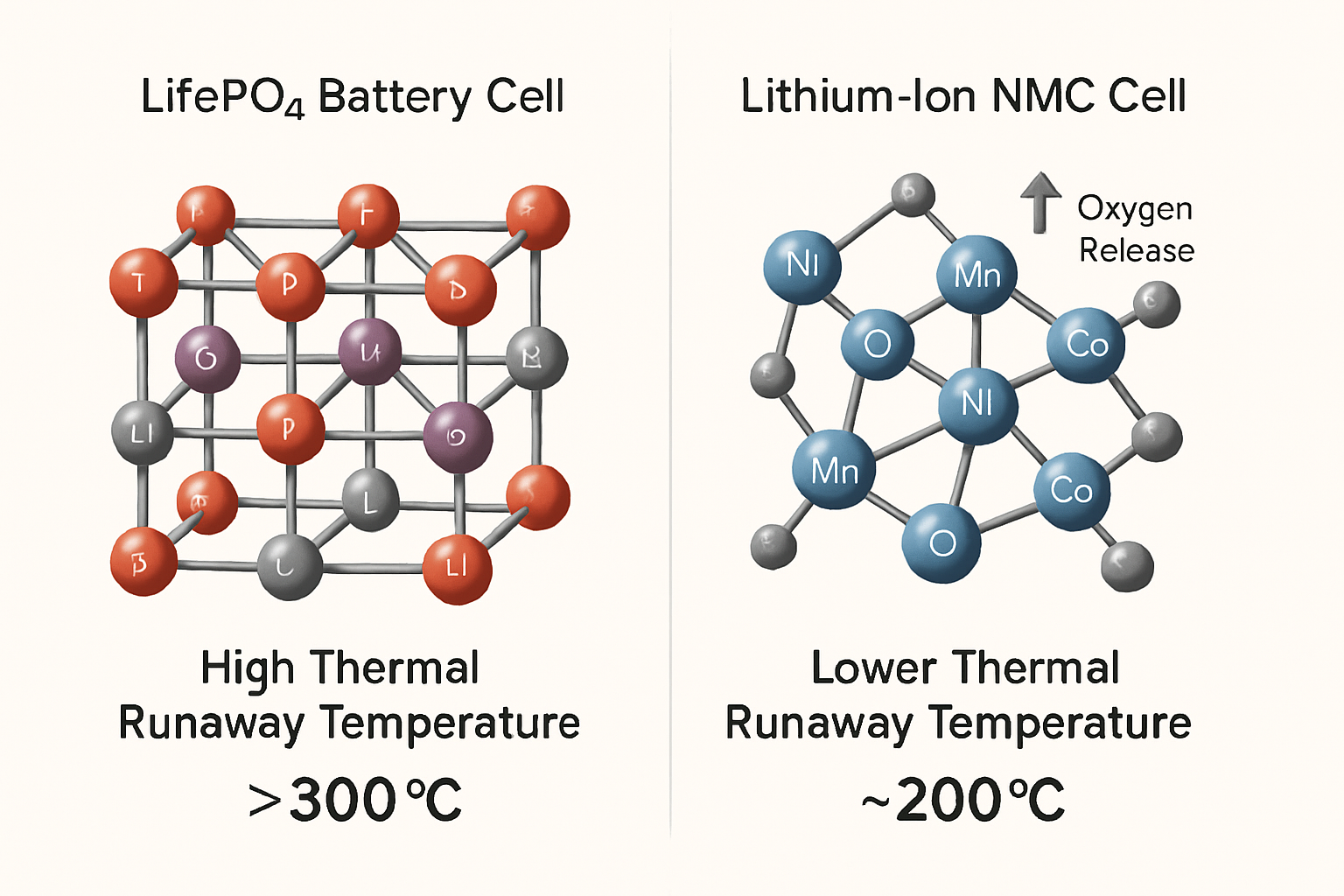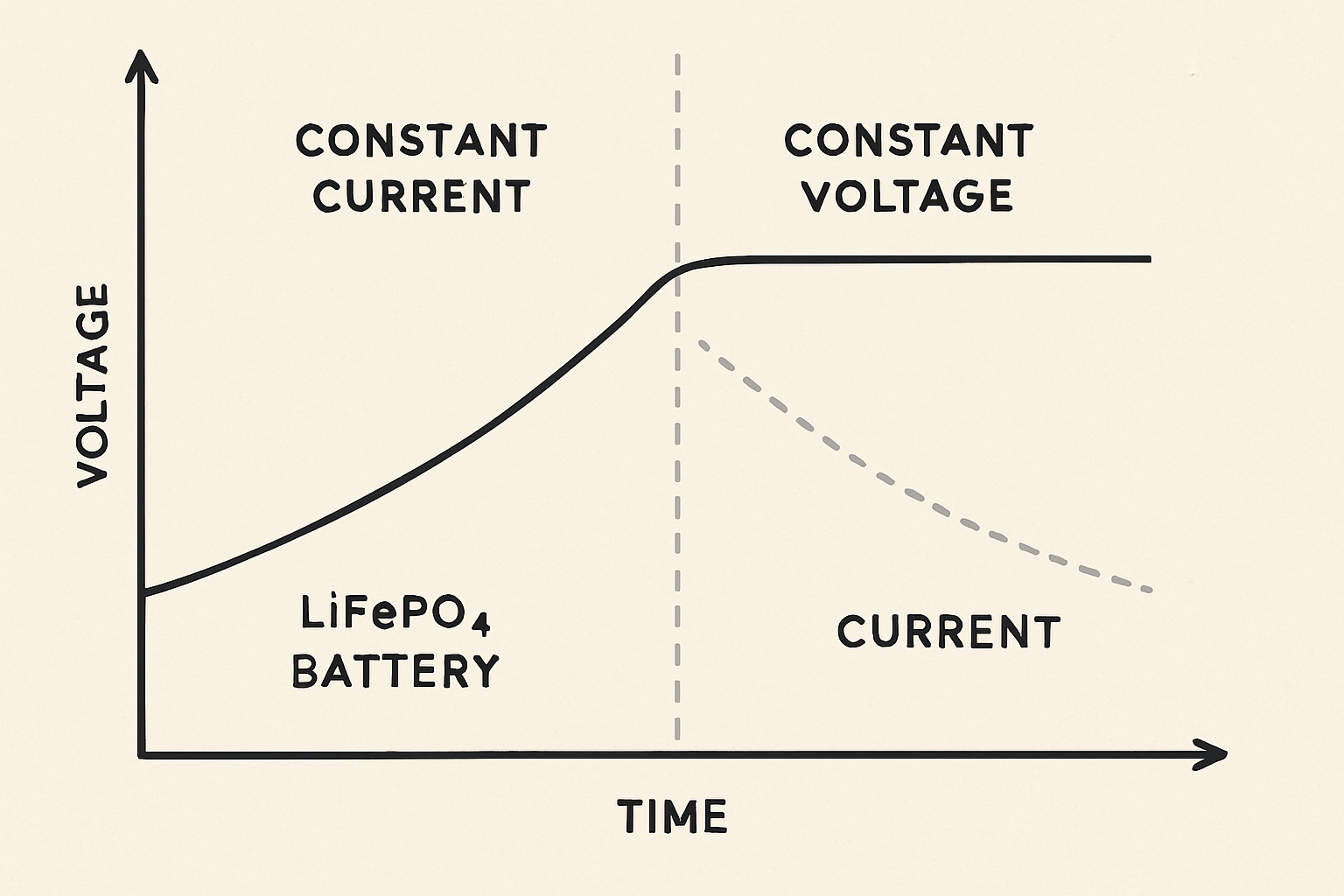Getting the charging voltage right for your Lithium Iron Phosphate (LiFePO4) battery is not a minor detail; it is fundamental to the longevity, safety, and performance of your entire energy storage system. Unlike older battery technologies, LiFePO4 chemistry requires precision. The correct voltage ensures you access the battery's full capacity while protecting your investment from premature degradation. This deep dive provides the specific parameters and technical understanding needed to configure your system correctly.
Understanding LiFePO4 Charging Fundamentals
Properly charging a LiFePO4 battery involves a controlled, multi-stage process. Understanding this sequence is the first step toward optimizing your setup. It is a system designed to charge the battery quickly and safely, preparing it for long-term, reliable operation.
The Two-Stage Charging Process: CC/CV
The most effective method for charging LiFePO4 batteries is the Constant Current/Constant Voltage (CC/CV) algorithm. This process unfolds in two distinct phases:
- Constant Current (CC): This is the initial or 'bulk' phase. The charger supplies a steady current, causing the battery's voltage to rise gradually. This phase is responsible for returning the majority of the energy to the battery.
- Constant Voltage (CV): Once the battery voltage reaches a specific setpoint (the absorption voltage), the charger switches to the CV phase. It holds the voltage steady while the current gradually decreases. The charging process is complete when the current drops to a low level, typically around 2-5% of the battery's Ah rating.
This CC/CV method ensures a fast yet gentle charge, preventing the cell stress associated with less sophisticated charging profiles.
Key Voltage Terminology Explained
When configuring your charging equipment, you will encounter several voltage settings. Each has a specific purpose:
- Bulk/Absorption Voltage: This is the target voltage for the CV phase, the most critical parameter for a LiFePO4 battery. Setting it correctly ensures a full charge without over-pressurizing the cells.
- Float Voltage: This is a lower voltage designed to maintain a full charge. For LiFePO4 batteries, a traditional float charge is not necessary. Once fully charged, it is best to stop the current completely. A 'float' setting in a LiFePO4 profile typically acts as a restart voltage, re-engaging the charge only when the battery self-discharges to a certain point.
Pinpointing the Optimal Charging Voltage
The precise voltage settings depend on the number of cells connected in series to create your battery pack. Accuracy here directly translates to battery health and cycle life.
Recommended Voltage Settings Per Cell
For a standard LiFePO4 cell, the recommended absorption charge voltage is between 3.60V and 3.65V. Charging above 3.65V per cell does not add significant capacity but does increase cell stress, leading to a shorter lifespan. Consistently charging below 3.55V may not fully charge the battery and can make it difficult for the Battery Management System (BMS) to perform its cell balancing function effectively.
Calculating Voltage for Your Battery Pack
To determine the correct settings for your system, you multiply the per-cell voltage by the number of cells in series (S). This simple calculation is vital for programming your solar charge controller or inverter-charger.
| Battery System | Cell Configuration | Recommended Absorption Voltage | Recommended Float Voltage (Standby) |
|---|---|---|---|
| 12V | 4S | 14.4V - 14.6V | 13.5V - 13.8V |
| 24V | 8S | 28.8V - 29.2V | 27.0V - 27.6V |
| 48V | 16S | 57.6V - 58.4V | 54.0V - 55.2V |
For example, a 12V LiFePO4 battery consists of 4 cells in series (4S). The ideal absorption voltage is 4 x 3.65V = 14.6V.
The Role of Temperature Compensation
LiFePO4 batteries are much more stable across a range of temperatures than lead-acid batteries. However, temperature still plays a critical role. The most important rule is to never charge a LiFePO4 battery when the temperature is at or below freezing (0°C or 32°F). Attempting to do so can cause lithium plating, a permanent and dangerous form of damage. A quality BMS will include a low-temperature cutoff to prevent this.
The Battery Management System (BMS): Your System's Guardian
The BMS is a non-negotiable component of any LiFePO4 battery pack. It is an electronic board that monitors and protects the battery on a cellular level, ensuring both safety and longevity. Its voltage regulation functions are paramount.
How a BMS Protects Against Voltage Issues
A BMS provides a critical safety net. It continuously monitors the voltage of each individual cell. If any cell's voltage exceeds the safe upper limit during charging (Over-Voltage Protection or OVP), the BMS will disconnect the charge circuit to prevent damage. Similarly, it prevents the battery from being overly depleted by disconnecting the load if any cell drops below a safe minimum voltage (Under-Voltage Protection or UVP).
Cell Balancing for Optimal Health
Minor differences between cells are inevitable in any battery pack. Over many cycles, these small variations can become significant, with some cells reaching full charge before others. A BMS performs cell balancing, typically during the end of the charge cycle. It uses small resistors to bleed a tiny amount of energy from the higher-voltage cells, allowing the lower-voltage cells to catch up. This ensures the entire pack charges uniformly, maximizing usable capacity and extending its service life.
Practical Application and Advanced Optimization
Applying this knowledge involves correctly configuring your system's components. From the solar charge controller to the inverter, every part must be set to the right LiFePO4 charging voltage parameters.
Setting Your Solar Charge Controller
When setting up your solar charge controller, avoid using presets for 'Gel' or 'AGM'. Always select a 'Lithium' or 'LiFePO4' profile if available. If not, use a 'Custom' or 'User-Defined' setting and manually input the absorption and float voltages from the table above. Set the equalization feature to 'Disabled', as this high-voltage process is for lead-acid batteries and is damaging to LiFePO4 cells.
Integrating with Inverters and Energy Storage Systems
For a complete residential energy storage system, the inverter-charger must also be programmed with the correct voltage parameters. As noted in an Innovation Outlook report from IRENA, smart charging strategies that manage how and when batteries charge are vital for maximizing the use of renewable energy. This includes ensuring all components in the system communicate and operate with harmonized settings. The interaction between the battery, inverter, and charge controller dictates overall efficiency; for a closer look at these dynamics, the ultimate reference on solar storage performance offers valuable data on how system components work together.
The Impact of Voltage on Long-Term Performance
For users prioritizing maximum cycle life over maximum single-charge capacity, there is an advanced strategy. Consistently charging to a slightly lower voltage—for example, 14.2V for a 12V system (3.55V per cell)—can reduce strain on the cells and potentially double the expected cycle life. This trades a small amount of usable capacity per cycle for a significant gain in overall longevity. The U.S. Department of Energy has highlighted that optimizing the power flow and operational parameters of energy systems is a key factor in building successful and durable solutions.
A Final Word on Charging Precision
Mastering the optimal charging voltage for your LiFePO4 battery is a direct investment in your energy independence. By setting your equipment to the precise values—such as 14.4V to 14.6V for a 12V system—and relying on a quality BMS, you ensure every charge cycle is safe and effective. This attention to detail protects the battery, maximizes its lifespan, and guarantees your solar energy storage system delivers reliable power for years to come.
Frequently Asked Questions
What is the absolute maximum charging voltage for a LiFePO4 cell?
While a LiFePO4 cell can technically handle up to around 3.8V for a very short time, exceeding 3.65V provides no practical benefit and significantly accelerates cell degradation. A properly configured BMS will trigger its over-voltage protection well before this point to prevent any damage.
Can I use a lead-acid battery charger for my LiFePO4 battery?
This is not recommended. Standard lead-acid chargers have voltage profiles and features, like equalization, that are unsuitable and potentially damaging to LiFePO4 batteries. Always use a charger with a specific LiFePO4 mode or a custom profile programmed to the correct CC/CV settings.
What happens if I consistently undercharge my LiFePO4 battery?
Consistently charging to a very low voltage (e.g., below 13.8V for a 12V system) means you will not be using the battery's full capacity. More importantly, it can prevent the BMS from having enough voltage headroom to properly balance the cells, potentially leading to cell imbalance over time.
Does float charging harm a LiFePO4 battery?
Traditional, continuous float charging is unnecessary for LiFePO4 batteries and can keep them at a high state of charge, which slightly increases calendar aging. A proper LiFePO4 charging profile will terminate the charge completely once the battery is full. The 'float' setting should be configured as a standby voltage (e.g., 13.6V for a 12V system) that only triggers a new charge cycle after the battery has rested and its voltage has dropped.





Leave a comment
All comments are moderated before being published.
This site is protected by hCaptcha and the hCaptcha Privacy Policy and Terms of Service apply.